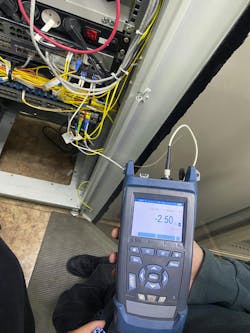“Good Enough” isn’t good enough: What most get wrong about optical test and measurement.
By Jake Weise / OgMentum
Nobody likes spending time and money on optical tests and measurement equipment, even though they need it. This shadowy corner of the optical networking world has always been a necessary evil for equipment manufacturers and network operators.
However, an informed test and measurement strategy that maximizes cost efficiency and scalability can lessen the pain and deliver tangible benefits to an organization.
Unfortunately, most opt for familiarity over ingenuity. “The equipment we’ve always used is good enough. Why change?” Instead, companies should ask themselves, “This worked in the past, but is it optimized for our current needs?” Comfort is the enemy of technological innovation, even in test and measurement. But how does the current industry landscape create an urgency to reassess this often-overlooked strategy?
Feeding the Beast
Artificial Intelligence (AI) and cloud computing are data hogs. They require faster networks, higher-performance optical components, and more channels and bandwidth to feed the beast. So, where do testing and measurement fit into these accelerating demands? Feeding these emerging technologies requires more infrastructure, which presents more aspects to validate. Validation requires test and measurement equipment suited to that infrastructure’s unique elements and parameters.
Companies can't rely on outdated, inefficient (or non-existent) test and measurement strategies to meet the heightened testing demands of the components enabling AI, cloud computing and other modern communications technologies. While testing accuracy and reliability are table stakes, companies can leverage specific considerations to fundamentally rethink their test and measurement strategy in conjunction with emerging technologies.
Three Vital Test and Measurement Considerations
1. Cost and Space: Cost is the primary source of disdain for test and measurement equipment purchasers. This equipment presents a healthy dose of sticker shock, particularly for specialized equipment, so purchasing the right equipment the first time is imperative. High-end specialization means companies pay a premium price because manufacturers know they must. However, companies should consider overall costs, not just upfront costs.
What are the integration, support, and maintenance costs? What’s the total cost of ownership? What are the calibration, repair, and replacement costs? A holistic strategy is vital in helping companies understand their equipment’s actual costs amid the telecommunications industry’s economic turbulence. Cost also has an interdependent relationship with space. Costs rise as emerging technologies require more components to be tested, and space becomes precious. Therefore, minimizing your equipment footprint can improve overall cost efficiency.
2. Throughput and Scalability: Testing throughput is of paramount importance, with many factors dictating this consideration, including:
· What testing is required?
· How long do the measurements take?
· Can devices be tested in parallel?
· How can we maximize the usage of our most expensive equipment?
· How many systems are needed?
· When and how do we add more equipment and test systems?
Despite their criticality, many companies overlook these points and don’t optimize for scalability when evaluating their test and measurement strategy. In test and measurement, scalability often relates to the modular versus discrete instrument debate, while the fully (or hybrid) integrated test system option is mainly overlooked. While modular and discrete instrument test platforms provide flexibility benefits, they also present higher costs and physical integrity risks. The instruments (modular or discrete) are externally interconnected in the test system. Companies must also buy and integrate the instruments separately, making these setups prone to management complexity and interconnect degradation risks.
Companies can consider their test system through sources, routing and conditioning, and measurement when deciding between a modular, discrete, or integrated approach. The routing and conditioning category often has more user-defined content, including boxed (or card) items such as Switches, Amplifiers and Variable Optical Attenuators (VOAs). However, it also usually includes loose components, such as splitters, circulators, and multiplexers/demultiplexers (MUX/DeMUX).
Flexibility is an advantage of modular or discrete approaches, but many companies do not reconfigure their test setups after they’re designed and built. Then, let’s say a test setup is assembled in the U.S. and shipped overseas for high-volume manufacturing. Repeated reconfigurations require documentation and support, which only heightens the risk of damage and human error. As a result, companies should evaluate the actual value of modularity in their test setup. For some companies, a fully modular or discrete equipment platform may provide justifiable returns on their investment. But by integrating even part of their test system, a company can benefit from a test solution that is less expensive, easier to scale, takes up less space and is easier to support – especially remotely.
3. Third-Party Expertise: In today’s business world, people often prefer to purchase equipment without ever speaking to a person. Although a test engineer may know intimately about the device they need to test, many are unaware of the complete offerings of the optical test and measurement market. As a result, engineers frequently choose what they have used in the past, preventing them from leveraging the advantages of available alternatives. Third-party experts specializing in fiber optic testing and measurement can help companies fill these knowledge gaps and mix and match offerings to optimize their measurement, cost, space, and scalability needs.
Leveraging expert knowledge can be much faster and more comprehensive than conducting time-consuming research independently. While a test and measurement expert may not fully understand a product’s intricacies, they can understand a company’s objectives and provide specialized knowledge of alternative test approaches and instrumentation that meets those objectives. This creates an opportunity for collaboration with a reputable distributor that can provide its expertise to support a company’s technical requirements and business needs, helping companies consider available alternatives to make the most informed test and measurement decisions.
The Value of Conducting a Test and Measurement Self-Assessment
Using the same test and measurement equipment and system configurations they've used for decades negatively impacts a company’s cost, space, and scalability requirements. This stagnancy is untenable amid rapid optical innovation and economic uncertainty. However, tests and measurement situations are not one-size-fits-all, so companies should evaluate how their unique business needs map to the test and measurement market’s current offerings.
Companies can leverage these considerations to conduct a self-assessment and optimize their test strategy, helping them ensure high-performance components that enable the newest wave of optical innovation. Among many setup options, there is one certainty in this era of rapid technological progress and growing competition: “Good enough” isn’t good enough for your test and measurement strategy.
Jake Weise has over 30 years of experience in the test and measurement field, leveraging his specialized expertise to establish deep technical understanding and strong relationships with global optical equipment and networking companies.

